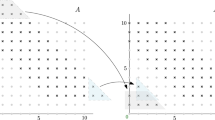Abstract
An almost affine code is a code C for which the size of all codes obtained by multiple puncturing of C is a power of the alphabet size. Essentially, almost affine codes are the same as ideal perfect secret haring schemes or partial affine geometries. The present paper explores these interrelations, gives short proofs of known and new results, and derives some properties of the distance distribution of almost affine codes.
Similar content being viewed by others
References
A. Beimel and B. Chor, Universally ideal secret sharing schemes, IEEE Transactions on Information Theory, Vol.40 (1994) pp. 786–794.
M. Bertilsson, Linear codes and secret sharing, PhD Thesis, Linköping University (1993).
G. R. Blakley and G. A. Kabatianskii, Linear algebra approach to secret sharing schemes, Error control, cryptology, and speach compression (Moscow, 1993), pp. 33–40. Lecture Notes in Comput. Sci. Springer, Berlin, 829 (1994).
E. F. Brickell and D. M. Davenport, On the classification of ideal secret sharing schemes, Journal of Cryptology, Vol. 4 (1991) pp. 123–134.
F. Buekenhout (ed.), Handbook of Incidence Geometry, Elsevier, Amsterdam (1995).
P. Delsarte, An algebraic approach to the association schemes of coding theory, Philips Research Reports Supplements, No. 10 (1973).
M. van Dijk, A linear construction of perfect secret sharing schemes, Advances in Cryptology- EUROCRYPT 94, Lecture Notes in Comput. Sci., Springer, Berlin, 950 (1995) pp. 23–34.
W. A. Jackson and K. M. Martin, Geometric secret sharing schemes and their duals, Designs, Codes and Cryptography, Vol. 4 (1994) pp. 83–95.
J. G. Oxley, Matroid Theory, Oxford University Press, Oxford (1992).
G. Pilz, Near-rings, North-Holland, Amsterdam (1977).
P. D. Seymour, On secret-sharing matroids, Journal of Combinatorial Theory B, Vol. 56 (1992) pp. 69–73.
F. J. MacWilliams and N. J. A. Sloane, The Theory of Error-Correcting Codes, North-Holland, Amsterdam (1983).
G. J. Simmons, How to (really) share a secret, Advances in Cryptology-CRYPTO 88, Lecture Notes in Comput. Sci., Springer, Berlin, 403 (1990) pp. 390–448.
J. Simonis, MacWilliams identities and coordinate partitions, Linear Algebra and its Applications, Vol. 216 (1995) pp. 81–91.
F. W. Stevenson, Projective Planes, Freeman, San Francisco (1972).
L. M. G. M. Tolhuizen, On maximum distance separable codes over alphabets of arbitrary size, Proc. 1994 IEEE International Symposium on Information Theory, Trondheim (1994) p. 431.
J. H. Van Lint and R. M. Wilson, A Course in CombinatoricsCambridge U.P., Cambridge (1992).
D. J. A. Welsh, Matroid TheoryAcademic Press, London (1976).
Author information
Authors and Affiliations
Rights and permissions
About this article
Cite this article
Simonis, J., Ashikhmin, A. Almost Affine Codes. Designs, Codes and Cryptography 14, 179–197 (1998). https://doi.org/10.1023/A:1008244215660
Issue Date:
DOI: https://doi.org/10.1023/A:1008244215660



